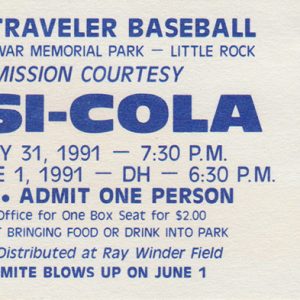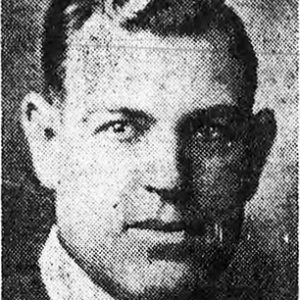calsfoundation@cals.org
Ray Winder Field
Ray Winder Field in Little Rock (Pulaski County) was the longtime home of the minor league baseball team originally known as the Little Rock Travelers, a name that was later changed to the Arkansas Travelers. Known as Travelers Field when it opened in 1932, the stadium’s name was changed in 1966 in honor of Ray Winder, whose involvement with the Travelers, in roles ranging from ticket taker to part-owner and general manager, spanned half a century.
The stadium, designed by the Little Rock architecture firm of Thompson, Sanders and Ginocchio, was built in 1931. It was located in what was known as Fair Park (later War Memorial Park), with the Little Rock Zoo as a neighbor to the west. In the 1960s, Interstate 630 began to be developed south of the park. To prevent balls from being hit out onto the highway, a fifty-five-foot right-field fence (the “Screen Monster” as it came to be called) was constructed in 1974. At the same time, some bleachers were removed, reducing capacity from 7,000 to about 6,000. The park had the same grandstand throughout its entire existence.
The stadium opened on April 13, 1932, and served as the home field for the Little Rock Travelers from 1932 through 1958 and then again from 1960 to 1961. The renamed and relaunched Arkansas Travelers called the stadium home from 1963 until 2006, when concerns about its safety, as well as the city’s desire for a more up-to-date venue, forced its closure. Ray Winder Field was also used by a variety of professional Negro League baseball teams during the 1940s and 1950s. The 1945 Little Rock Black Travelers used it while a part of the Negro Southern League, and the legendary Birmingham Black Barons and Kansas City Monarchs both used the field.
The final game hosted in Ray Winder Field took place on September 3, 2006, and saw the Travelers defeat the Springfield Cardinals 7–2 in front of 8,000 fans, the second-largest turnout in team history. The venerable Ray Winder Field was one of the oldest active ball parks in the country, exceeded only by Fenway Park and Wrigley Field at the Major League level and perhaps a handful of minor league parks.
After the team moved to Dickey-Stephens Park in North Little Rock (Pulaski County), the field sat vacant for about five years while local officials tried to decide what to do with it. Efforts to designate it as a historic site were met with resistance. Some sought to allow the neighboring zoo to use it as a viewing area for certain exhibits, but the stadium and the land were eventually sold to the University of Arkansas for Medical Sciences (UAMS), with the structures to be demolished and the land used for a parking lot. However, UAMS officials announced that the scoreboard would be incorporated into any new structure, with UAMS messages replacing previous advertisements.
Prior to the July 2012 demolition, fans were given an opportunity to secure keepsakes. In November 2007, the city held the “Ray Winder Field Yard Sale,” in which anything not nailed down was sold, and, in May 2011, fans were allowed in on a first-come, first-served basis to claim stadium seats.
For additional information:
Bailey, Jim. The Arkansas Travelers: 79 Years of Baseball. Little Rock: Arkansas Travelers Baseball Club, 1980.
“Ray Winder Field.” Arkansas Roadside Travelogue. http://arkansasroadstories.com/history/raywin.html (accessed November 26, 2025).
Reichard, Kevin. “Ray Winder Field/Arkansas Travelers.” Ballpark Digest, December 1, 2006. http://ballparkdigest.com/200612011047/minor-league-baseball/news/ray-winder-field-arkansas-travelers (accessed November 26, 2025).
Traub, Todd. The Last At-Bat: The Arkansas Travelers at Ray Winder Field . Little Rock: WEHCO Publishing, 2006.
William H. Pruden III
Ravenscroft School









Comments
No comments on this entry yet.